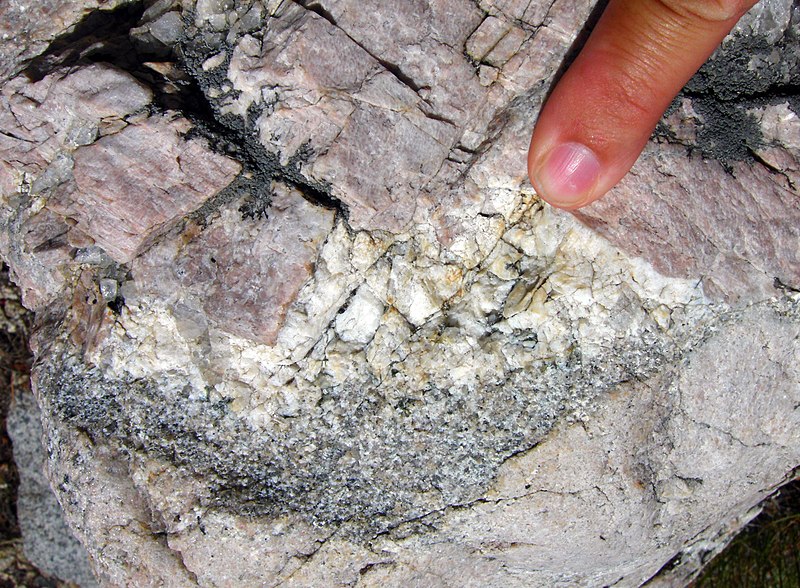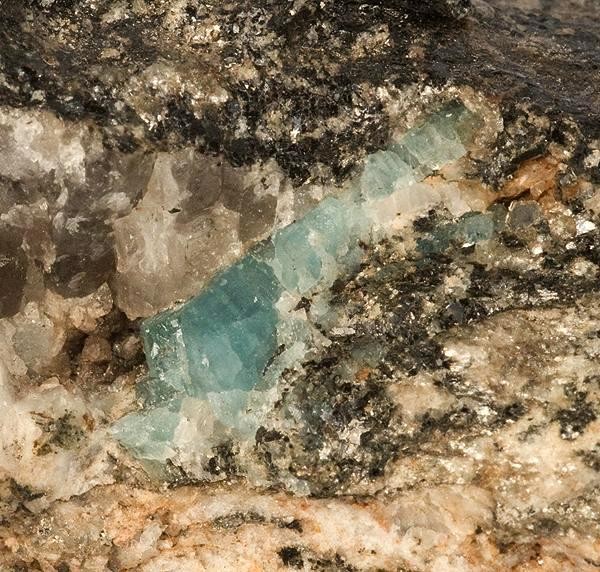 |
| A pegmatite vein in a roadcut. Photo by Woodlouper |
The next several articles that are going to be published in this blog concern a very special type of rock formation that is called pegmatites. Another name that is sometimes used for this rock is giant granite because the large sized crystals of different minerals that are found in them. The most common minerals in a pegmatite are feldspar, mica and quartz with quartz in many pegmatites making up almost 50% of the total minerals present.
Although they are described as veins of pegmatite most of them are tabular shape masses of rock that are injected as a granitic magma into pre-existing cracks in the country rock, or sometimes they also form large ovals that are more or less deformed by earth movements that occur at the same time they are being deposited deep in the earth.
| A pegmatite mine. Photo by Pfuss |
The crystals are found in a pegmatite are the result of very slow cooling that occurs in the depths of the earth's crust several miles beneath the surface. The pegmatites that are now exposed at the surface have all had several miles of rock eroded away so we can now see them at the surface.
Although most pegmatites are at home in gneiss or schist some of them are actually found in granite intrusions that have taken a long time to cool so that the pegmatite grades from granite. That only pertains to some of pegmatites, it is theorized that changes in the chemical composition can cause some pegmatites to be formed in a very short time; sometimes a matter of days and still have large sized crystals.
 |
| Closeup of a pegmatite Photo by Mark A. Wilson |
Unless a pegmatite is within a granitic intrusion they are all outliers of such an intrusion. The further a pegmatite is from the parent intrusion the more likely it is to have rare minerals in its composition. There are three main types of pegmatites of granitic composition and the fourth that is found in more mafic rocks such as gabbro. The further they are from the granitic or gabbro like intrusion the more apt they are to contain the proper chemical ingredients to form gemstones.
There are generally three major minerals and under the right conditions can form gemstones, they are beryl, topaz and tourmaline. There are also more than 100 other minerals that under the right conditions can also form gemstones. Sometimes even the body of the pegmatite itself is code is cabochons if it is especially attractive. Graphic granite that is found in some pegmatite makes especially attractive
 |
| The rare mineral "bazzite" found in a pegmatite cavity. This is an analog of beryl containing the rare earth element scandium. Photo by Rob Lavinsky |
Many pegmatites display different zones that are apt to contain different suites of minerals. The outer portion of a pegmatite displays very fine crystals and is often termed an aplite. There are several different shells that a pegmatite can display numbering up to seven. The inner core of all zoned pegmatites is usually quartz and in the inner core is where you usually find cavities that are filled with flawless crystals of various gemstones. Although it is unusual there are many instances where a single large cavity can produce several million dollars worth of gemstones.
No comments:
Post a Comment